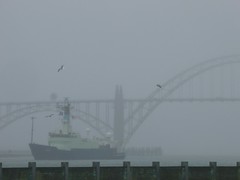 NEWPORT – OSU’s Hatfield Marine Science Center will open its doors a bit wider on Saturday, April 14, when the Newport facility hosts its first Marine Science Day.
NEWPORT – OSU’s Hatfield Marine Science Center will open its doors a bit wider on Saturday, April 14, when the Newport facility hosts its first Marine Science Day.
The free public event, which runs from 10 a.m. to 4 p.m., will feature scientists and educators from OSU, federal and state agencies, the Oregon Coast Aquarium, and the new NOAA Marine Operations Center-Pacific. It offers a rare opportunity for the public to go behind the scenes of one of the nation’s leading marine science and education facilities.
Oregon Sea Grant and its marine education program will offer special activities at the HMSC Visitor Center, and behind-the-scenes tours of its ornamental fish laboratory.
Oregon First Lady Cylvia Hayes will speak briefly at 3 p.m. in the Visitor Center auditorium, along with OSU Vice President for Research Richard Spinrad. Bruce Mate, director of OSU’s Marine Mammal Institute, will follow with a presentation showcasing the center’s pioneering role in tracking whales by satellite.
“Marine Science Day will be fun and engaging for people of all ages,” said Maryann Bozza, HMSC program manager. “Visitors will wind through the campus, getting a true behind-the-scenes experience with an unparalleled opportunity to learn directly from marine scientists.”
Most Marine Science Day exhibits and activities will be indoors, but some tours will take visitors outside to walk from one lab to another, and some exhibits will be outdoors.
“The diverse science conducted at the facility reaches from local coastlines and estuaries to the depths of the world’s oceans,” she added, “and in scale from microbes on the seafloor to undersea volcanoes and the whales that swim over them.”
Visitors can meet Pearl, the Visitor Center’s newest octopus and watch her being fed at 1 pm; observe a sea turtle necropsy; and meet fisheries scientists and geologists whose research is described in center exhibits. The public also can participate in self-guided tours through the facility’s marine research labs, library and classrooms, where scientists will have interactive exhibits explaining their research. Highlights include:
- Hear volcanoes erupt and whales ‘sing’ in an audio display by NOAA and OSU researchers using undersea hydrophones
- Learn how researchers are supporting sustainable fisheries through innovative, collaborative research
- Collect biological data from fish, plankton and even a shrimp parasite through hands-on experimentation
- Explore novel oceangoing and ocean floor instrument platforms and meet the scientists who designed them.
Visitors may also take guided tours of HMSC’s seawater facilities and ornamental fish laboratory. More information, including program and special events, is available at on the HMSC Website.
The event is intended to showcase OSU’s unique partnership with state and federal agencies, which makes the HMSC a national leader in marine research and education, according to director George Boehlert.
“OSU’s Newport campus is known for a diversity of research and the expertise of its scientists, which offer unique opportunities in education and outreach,” Boehlert said. “Visitors to Marine Science Day will get a sense of the innovation and synergy that makes the Hatfield Marine Science Center unique.”
Collaborative research partners that share the campus with OSU labs include six federal and state agencies: National Oceanic and Atmospheric Administration (NOAA) Fisheries and NOAA Research, Oregon Department of Fish and Wildlife, U.S. Environmental Protection Agency, U.S. Fish and Wildlife Service, U.S. Geological Survey, and U.S. Department of Agriculture.
 NEWPORT – Dr. Shawn Rowe, Oregon Sea Grant’s marine education learning specialist, is the scientist on tap at Rogue Ales’ Brewer’s on the Bay this Friday evening, talking about how people learn science outside the conventional classroom.
NEWPORT – Dr. Shawn Rowe, Oregon Sea Grant’s marine education learning specialist, is the scientist on tap at Rogue Ales’ Brewer’s on the Bay this Friday evening, talking about how people learn science outside the conventional classroom.







